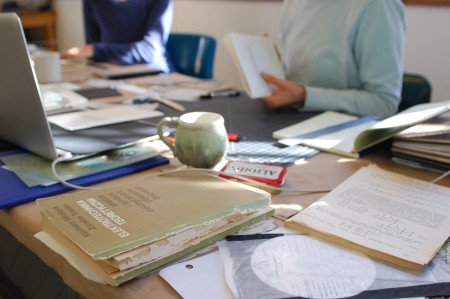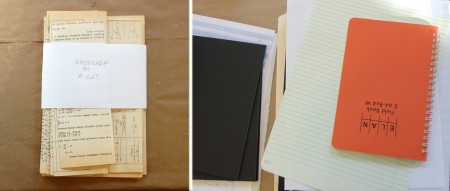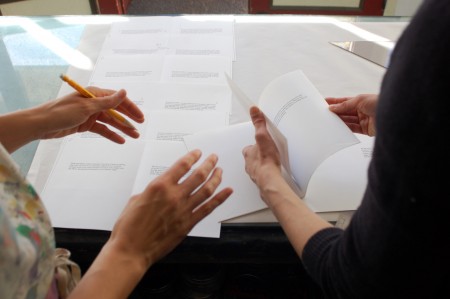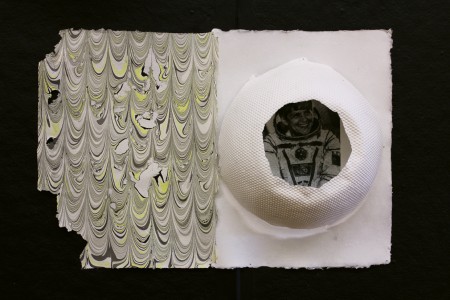Fly Me to the Moon: Sarah Peters in the Studio
September 30, 2013Over the next few weeks, we’re tracking our book resident Sarah Peters’s project The Moon Has No Weather. This is the first post in the series.
If not for the hand-marbled paper, bits of abaca and Thai mulberry, polymer plates, and paper casts that look like chunks of lumpy lunar surface, you’d be forgiven for thinking at first glance at her workspace that Sarah Peters was some kind of scientist. In our studio, Sarah has piles of materials splayed out around her: several different kinds of green and blue graph paper, flowchart drawing templates from IBM, lab notebooks, pages pulled from Elektotechnika Teoretyczna, a Polish instruction manual published in 1984.
Really it’s the collection of materials, textures, and references informing her book The Moon Has No Weather, which explores the moon as an archive of the entirety of its cosmic history.


“If I could take a sabbatical and create a self-directed masters program it would be in the cultural history of the moon,” she says, and she’s probably not joking. “I am completely fascinated by it. Tons and tons of people have this same fascination. Why? What is it about the moon? Is it that we can all see it and it’s there forever? That we’ve gone to it? That now we can mine it?”
Sarah could talk about the moon, and the space race, and its narratives of nationalistic heroism, and its captivation of public imagination, all day. But there’s work to do. Just past the midpoint of her seven-week Artist’s Book Residency, Sarah needs to finish printing all the text pages and all the inserts this week, leaving two weeks for assembly, in order to stay on schedule.
Her first two weeks Sarah pulled paper and prototyped structures, troubleshooting material issues. She’s grappled with problems like the fact that none of the found paper she wanted to use was archival, or that the pages of Elektotechnika Teoretyczna are“totally not square in about seven different ways.” And that she refuses to just print her own versions of these papers because their origins as scientific materials are conceptually important. (“I just love these papers as they are. They’re so beautiful and perfect.”)
Like an archivist or researcher, Sarah works by culling information from text, imagery, objects, design elements, theories, ideas, and historical narratives. On one hand she’s collecting materials and exploring their formal possibilities, and on the other she’s reading, listening to, and watching everything she can about her exceptional range of interests. Then, suddenly: “When I get lucky, a little road gets built between these parallel worlds and in there is a kernel for an actual project.”
The Moon Has No Weather grew from an installation Sarah created at the Minnesota Center for Book Arts while she was experimenting with casting colanders: the resulting paper spheres looked like fragments of satellites or space junk. And her hand-marbled paper resembled the swirling surface of planets seen through telescopes. And there was a gorgeous 1885 book called The Moon Considered as a Planet, a World, and a Satellite. And a podcast about the moon having no weather – no changing atmosphere – to disrupt its atomic material, so that its surface acts as a preserved record of its history. The road was built, and the project was born.
“Books are my favorite thing. I love the idea of the book as a time-based medium where you build the experience for the viewer and reveal information along the way,” she says. “I keep using this word ‘information’, right? It sounds really technical, dry, and quantifiable. But that’s how I think about it: color is information, drawings are information.”
For Sarah and planetary scientists alike, even the moon’s lunar dust contains information – an idea at once mind-blowingly inconceivable and also extremely poetic.
“The universe is a really super beautiful thing, and it’s really hard not to get cheesy about it,” Sarah nods. And when using found materials that are already beautiful by virtue of their age – and the way they record their own histories in their stains and fading – Sarah always asks herself, “Am I doing enough? Am I pushing the materials and ideas far enough? These are important questions for any artistic practice. What I love about this project is it’s opening up more material and conceptual exploration. I’m not done with the moon.”
Sarah Peters is a Minneapolis-based artist, writer, and arts programmer who does not have a website, and admits this is a problem. She is a 2003 recipient of a WSW Artists’ Book Residency Grant, during which she created Necessary Disclosures. Check back soon for part two of our conversation with Sarah, where we’ll discuss her first visit to the Binne and her art practice in the 10 years since. See more images of her residency here.






